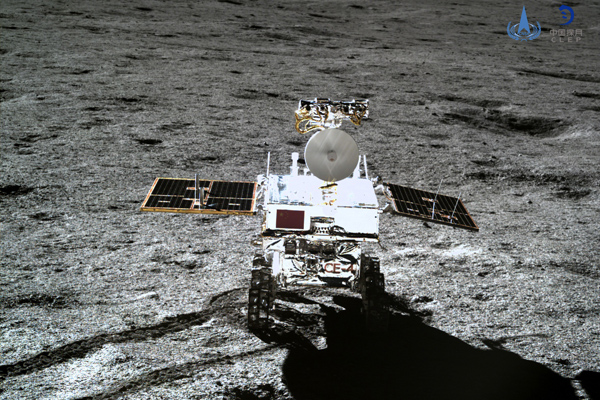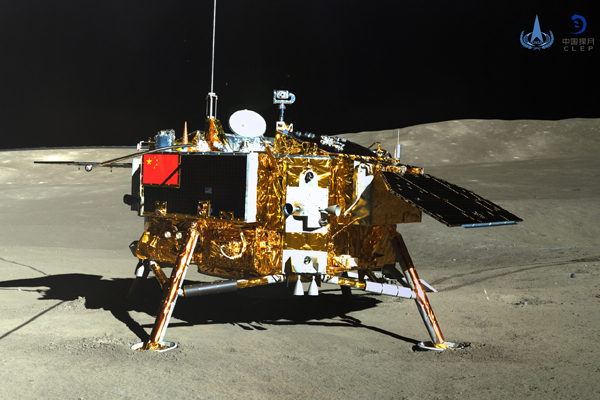
Photo taken by the lander of the Chang’e-4 probe on Jan 11, 2019 shows the rover Yutu-2 (Jade Rabbit-2). China announced on Jan 11 that the Chang’e-4 mission, which realized the first-ever soft-landing on the far side of the moon, was a complete success. With the assistance of the relay satellite Queqiao (Magpie Bridge), the rover Yutu-2 (Jade Rabbit-2) and the lander of the Chang’e-4 probe took photos of each other.[Photo/Xinhua]
BEIJING — China announced on Jan 11 that the Chang’e-4 mission, which realized the first-ever soft-landing on the far side of the moon, was a complete success.
With the assistance of the relay satellite Queqiao (Magpie Bridge), the rover Yutu-2 (Jade Rabbit-2) and the lander of the Chang’e-4 probe took photos of each other.
The scientific instruments aboard the probe worked well, and the images taken by the probe and detection data have been sent back to ground control, said the China National Space Administration (CNSA).
At 4:47 pm Beijing Time on Jan 11, the images of the lander and rover appeared on a large screen at the Beijing Aerospace Control Center, showing the Chinese national flag on both the lander and the rover with landscape dotted with craters in the background.
The Chang’e-4 probe touched down at the preselected landing area at 177.6 degrees east longitude and 45.5 degrees south latitude in the Von Karman Crater in the South Pole-Aitken (SPA) Basin on the far side of the moon on Jan 3, with the rover driving onto the lunar surface late that night.
The rover then took a “nap” as solar radiation raised the temperature on the lunar surface to over 100 degrees Centigrade. It restarted its work on Jan 10.
The lander, the rover and the relay satellite are in good condition. After the lander and the rover photograph each other, the probe will start scientific detection, the CNSA said.
Named after Chinese moon goddess “Chang’e,” China’s lunar exploration program, which began in 2004, includes orbiting and landing on the moon and bringing samples back to Earth.
The program has achieved five continuous successes, said CNSA, referring to Chang’e-1, Chang’e-2, Chang’e-3, a test craft for Chang’e-5 and Chang’e-4.
One of the images published by CNSA earlier on Jan 11 is a 360-degree panorama, which was pieced together from 80 photos taken by a camera on the lander, according to Li Chunlai, deputy director of the National Astronomical Observatories of China and commander-in-chief of the ground application system of Chang’e-4.
“From the panorama, we could see the probe was surrounded by many small craters. It was really thrilling,” Li said.
“One of the craters close to the rover Yutu-2 has a diameter of about 20 meters and a depth of about 4 meters. The rugged terrain will pose great challenges for planning the route of the rover.
“Compared with the landing site of the Chang’e-3, which was sent to the Sinus Iridum, or the Bay of Rainbows, on the moon’s near side, fewer rocks can be found in the area surrounding Chang’e-4, indicating the landing area of Chang’e-4 might be older.”
The CNSA also released a video of the landing process of the Chang’e-4, which was produced by processing more than 4,700 pictures taken by a camera on the probe.
The video, lasting about 12 minutes, showed that the probe adjusted its altitude, hovered and avoided obstacles during the descent.
“From the video, we can see more dust was thrown up when the Chang’e-4 touched down on the far side of the moon compared with the landing of Chang’e-3, indicating that the lunar dust at the landing area of Chang’e-4 is thicker than the region where Chang’e-3 landed,” said Zhang Hongbo, chief designer of the ground application system of Chang’e-4.
“The thicker dust shows that the lunar regolith in the region has undergone longer space weathering, which also gives strong evidence of the region being older. We will conduct comparative research between the landing areas of Chang’e-3 and Chang’e-4,” Li said.
As a result of the tidal locking effect, the moon’s revolution cycle is the same as its rotation cycle. It always faces Earth with the same side, and the far side was a mystery before the age of space travel.
Many lunar orbiters had shown that the moon’s two sides were very different: the near side is relatively flat, while the far side is thickly dotted with impact craters.
“We hope Chang’e-4 could carry out unprecedented and more challenging tasks,” said Wu Weiren, chief designer of China’s lunar exploration program.
“The far side of the moon has unique features, and has never been explored on site, so Chang’e-4 might bring us breakthrough findings,” said Zou Yongliao, director of the lunar and deep space exploration division of the Chinese Academy of Sciences.
The scientific tasks of the Chang’e-4 mission include low-frequency radio astronomical observation, surveying the terrain and landforms, detecting the mineral composition and shallow lunar surface structure, and measuring neutron radiation and neutral atoms.

Photo taken by the rover Yutu-2 (Jade Rabbit-2) on Jan 11, 2019 shows the lander of the Chang’e-4 probe.[Photo/Xinhua]

The screen at the Beijing Aerospace Control Center shows the Chang’e-4 lander (R) and the Yutu-2 rover taking pictures for each other, Jan 11, 2019.[Photo/Xinhua]

Technicians work at the Beijing Aerospace Control Center (BACC) in Beijing, capital of China, Jan 11, 2019. [Photo/Xinhua]
